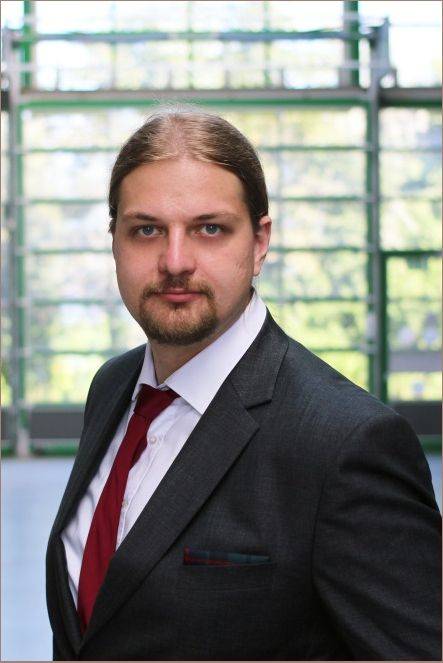[ihc-hide-content ihc_mb_type=”show” ihc_mb_who=”reg” ihc_mb_template=”3″ ]
[vc_row][vc_column][vc_column_text]Credit – http://am.vdma.org
AIM3D GmbH, a young company in Rostock, is driving its own additive manufacturing technology with composite extrusion modeling (CEM), and building corresponding systems. In this interview, their general manager Dr. Vincent Morrison explains how CEM differs from existing AM technologies, which materials to process with it, and how he imagines a typical AM process chain of the year 2030.
 Could you please provide us with a short introduction to AIM3D?
Could you please provide us with a short introduction to AIM3D?
Dr. Vincent Morrison: With pleasure. Our company has been founded out of the University of Rostock, and since February 2017, we have officially been registered as a company, and today, we have ten employees. During our studies, we got to know AM systems by different manufacturers, and we noticed a few weaknesses. High costs, complicated handling, and lacking practicability: starting with explosion prevention and work safety up to the rather problematic powder handling. Since 2014, we have been working towards our goal of developing an uncomplicated, more cost-efficient AM technology. In doing so, we got to metal/ceramic injection molding. MIM and CIM are established technologies for which there are construction guidelines and a very broad range of granulates. These are made out of thermoplastics filled with metals, ceramics, or fibers. Based on these granulates, we have developed our composite extrusion modeling (CEM) technology and filed a patent application. Our first system will be marketed in the coming days. It melts granulates and presses those through a nozzle via a screw extruder. Like in FFF technology, the material extruded in strands gets built up layer by layer to form a component. Then, either chemically or thermally, the binder material is removed, and finally the component gets compacted in a sintering process.
Which materials can be processed in this manner?
Morrison: Nearly all available injection molding granulates which exist with metal fillings of stainless steels and tool steels, hard metals, even non-ferrous metals like copper, aluminium 6061, titanium 64, and wolfram. Next to these, ceramic fillings are available, like aluminium and zirconium oxide or silicon nitride. And there are various plastics granulates, among them also glass or mineral fiber-filled thermoplastics. All these materials have matured through decades and become qualified. Among other things, their manufacturers give such exact details on their shrinkage during a sintering process that construction engineers can know up to the third position after decimal point by what percentagethey need to increase components in design. Users can rely on the said construction guidelines which offer answers on questions of overhang or very large components.
Which part of the value chain of additive manufacturing do you cover?
Morrison: We have developed a compact extruder that processes the said multitude of metal, ceramic, or fiber-filled granulates, and which can reach build-up rates of up to 160cm3 per hour depending on the nozzle, and which guarantees highest process stability without cleanroom or drying room conditions, and without any measures for explosion prevention. Handling is very uncomplicated. There are also advantages in material costs by factor 3 to 10 compared to filaments or powdered AM materials. Our technology is open and adjustable. Thus, customers can freely choose the nozzle’s diameter – down to 250 µm. And they can choose between water, solvent-based, or catalytic material systems. The latter can be quickly and comprehensively debinded in the oven by adding nitric acid, even if the components are massive and highly complex. We want to create the preconditions so our customers will be able to specialize with time, and to experiment as they wish.
Where do you see the highest need for development in the AM sector?
Morrison: In my view, the most urgent tasks lie in cost reduction and quality management. Automation on a grand scale only makes sense when these get solved. Automation alone cannot solve the cost problems in additive manufacturing. Building costs of most AM technologies are between 600 and 1,200€/kg. For many applications, this is just too much. In order to consider it as a series technology, not only does the cost problem need to be solved, there is also the question of quality. After all, efficient quality control is a mandatory precondition in many sectors.
How do you imagine a typical AM process chain in the year 2030?
Morrison: In our case, I imagine that up to twenty of our systems will be positioned around a large sintering oven. With our systems, profitability depends less on 3D printers and more on the oven’s size. Just as I see a need for automation, I see big potentials for our technology especially with medium-sized components that are up to 20 cm and in batch sizes of 50 to 2,000. In 2030, the 3D-printed green bodies might be removed by robots and get transported to the oven via a conveyor belt.
Final question: what were your goals in joining the Additive Manufacturing Association within VDMA?
Morrison: Currently, we are experiencing an advantage in that we as a start-up can arrange a joint booth at formnext (November 13th to 16th, 2018, in Frankfurt) with renowned companies from the Association. In general, I value how the platform brings together like-minded people who are ahead of their time and the market. The multitude of perspectives and dealing with new lines of thought all help us tremendously in adjusting our products in a better, more sensible way to the future and the market.[/vc_column_text][/vc_column][/vc_row]
[/ihc-hide-content]
The AM Chronicle Editorial Team is a collective of passionate individuals committed to delivering insightful, accurate and engaging stories to additive manufacturing audiences worldwide.



